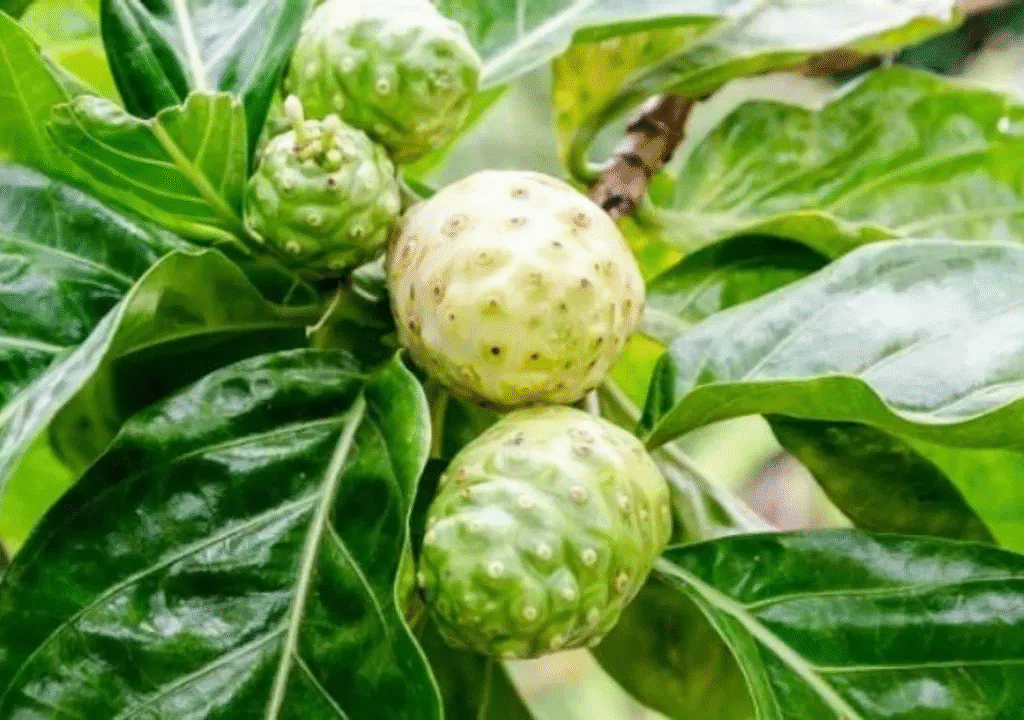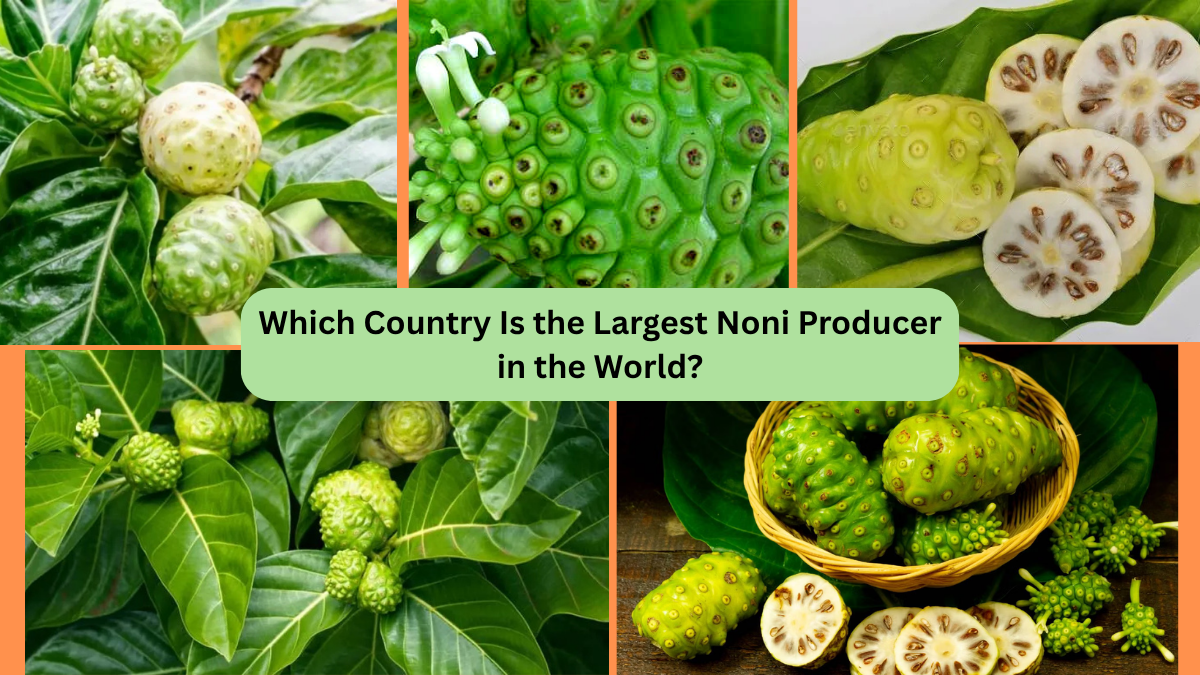What Is Noni?

Noni (Morinda citrifolia) is a tropical evergreen tree native to Southeast Asia and Australasia, later spread across the Pacific by Polynesian voyagers . The fruit, rough with a pungent aroma, is often likened to cheese or vomit—yet it remains prized in traditional medicine and specialty food and wellness markets worldwide .
Noni trees are hardy, thriving in diverse conditions including salty, sandy soils, volcanic terrain, or coastal atolls, and bear fruit year-round, typically yielding 4–8 kg per month en.wikipedia.org.
The Top Noni Producing Countries
Although there are no standardized global crop reports for noni, a combination of historical cultivation, export data, and the presence of major processing companies narrows down the leading producers.
French Polynesia (Tahiti)
- Often considered the primary commercial center of noni, Tahiti was an early pioneer in noni juice production.
- In the late 2000s, organic noni exports reached 150–200 t/year reddit.com+10fr.wikipedia.org+10en.wikipedia.org+10.
- Local marketers secured EU Novel Food approvals (2003–2010), anchoring Tahiti’s role in juice exports to Europe pmc.ncbi.nlm.nih.gov.
- While production declined throughout the 2000s, strategic branding cemented Tahiti as noni’s most recognized exporter.
Indonesia, India, Southeast Asia
- Noni is deeply woven into traditional agriculture across Indonesia, Philippines, Malaysia, Thailand, and India (especially Andaman and Nicobar islands) sciencedirect.com+3researchgate.net+3reddit.com+3.
- Smallholder farmers combine juice, powders, medicinal usage, and dye production pmarketresearch.com+11en.wikipedia.org+11pubmed.ncbi.nlm.nih.gov+11.
- Research from India reports backyard harvests of 10 fruits per tree per month, with growers branching into juice and fiber products reddit.com.
Hawaii & Other Pacific Islands
- In Hawaii, noni is both a cultural plant and a commercial crop en.wikipedia.org+15en.wikipedia.org+15reddit.com+15.
- Companies in Fiji, Cook Islands, and Samoa produce certified organic noni—supporting small but consistent domestic and export markets .
So, Who’s #1?

Key Criteria for ‘Largest Producer’
| Factor | Winner |
|---|---|
| Volume (Organic Juice Exports) | French Polynesia (~200 t/year) sciencedirect.com+3en.wikipedia.org+3sciencedirect.com+3 |
| Process Infrastructure & Global Marketing | French Polynesia (EU-certified brands like Tahitian Noni, Morinda Inc.) |
| Scale of Cultivation | Indonesia/India – wider but fragmented and mostly non-export |
So overall, French Polynesia (Tahiti) stands as the world’s largest commercial noni producer and exporter. Its global branding, early regulatory approvals, and meaningful export volume—though modest—make it the undisputed leader.
Why Tahiti Leads the Pack

1. First-Mover Advantage
Tahiti was among the first to brand noni as a health drink, launching juice commercialization in the early 1990s fr.wikipedia.org+1en.wikipedia.org+1researchgate.net+7arabjchem.org+7en.wikipedia.org+7.
2. Organic Certifications
By 2002–2004, producers achieved organic status and EU approval, enabling smooth export lines and premium pricing .
3. Brand Power
Companies like Morinda/Tahitian Noni International build on Tahiti’s image (“Tahitian Noni®”), securing major presences in North America, Europe, and Asia reddit.com+5en.wikipedia.org+5reddit.com+5.
4. Yield & Processing
Though cultivations are limited geographically, yields of up to 200 t/year—plus juice, powder, oil, and cosmetic production—solidify Tahiti’s status .
The Bigger Picture: Global Production vs. Commercial Output

- Indonesia, India, Thailand, Philippines, Fiji: Millions of noni trees across farms and gardens; most fruit processed locally or used medicinally reddit.com+1reddit.com+1.
- Tahiti: Centralized, export-oriented, EU-approved operation focusing on global markets.
- Countrywide yield vs. Export-strength: Tahiti’s totals may be overshadowed by aggregation in Indonesia/India but globally, export volume and marketing impact are unmatched.
Uses, Benefits, and Market Trends
- Traditional uses: Antimicrobial, anti-inflammatory, digestive remedies; leaves and roots used in Southeast Asia en.wikipedia.org+1pubmed.ncbi.nlm.nih.gov+1.
- Commercial derivatives: Juices, capsules, powders, skincare, essential oils .
- Nutritional content: High in vitamin C, potassium, dietary fiber; packed with flavonoids, anthraquinones, iridoids, and polysaccharides sciencedirect.com+1pubmed.ncbi.nlm.nih.gov+1.
Challenges & Opportunities

Challenges:
- Taste and aroma: Often considered extremely unpleasant—dubbed “vomit fruit” reddit.com+1reddit.com+1.
- Regulatory scrutiny: FDA warning letters signal caution in health claims en.wikipedia.org+1en.wikipedia.org+1.
- Quality inconsistency: Lack of standardized markers for commercial products .
- Economic pressure: Yield and market sustainability concerns sciencedirect.com.
Opportunities:
- Functional beverage growth: Global noni juice market forecasted to grow ~5% annually through 2030 pubmed.ncbi.nlm.nih.gov+7pmarketresearch.com+7pmarketresearch.com+7.
- Product diversification: Potential in blended superfood drinks, topical cosmetics, and dietary supplements.
- Sustainable branding: Tahiti’s organic and tropical origins support niche premium positioning.
Final Verdict
To answer definitively: French Polynesia (Tahiti) is the largest commercial noni producer in the world—leading in export volume, brand identity, and regulatory approvals. While larger areas of cultivation exist in countries like Indonesia and India, their output is mostly used domestically, lacking global impact.
Tahiti’s niche yet powerful infrastructure—from certified cultivation to global branding—secures its position as the face of the commercial noni market.





